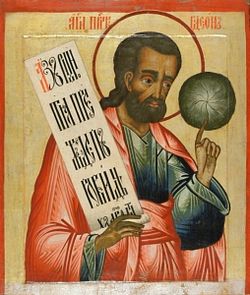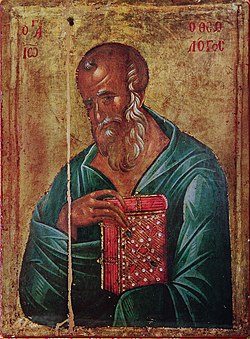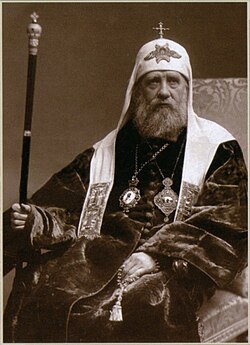Top Qs
Timeline
Chat
Perspective
September 26 (Eastern Orthodox liturgics)
From Wikipedia, the free encyclopedia
Remove ads
Sep. 25 - Eastern Orthodox Church calendar - Sep. 27

All fixed commemorations below celebrated on October 9 by Orthodox Churches on the Old Calendar.[note 1]
For September 26th, Orthodox Churches on the Old Calendar commemorate the Saints listed on September 13.
Saints
- Righteous Gideon, Judge of Israel (c. 1307 BC)[1][2][3][4][5][note 2]
- Repose of the Holy Apostle and Evangelist John the Theologian (2nd century)[1][3][6][note 3]
- Virgin-martyrs Thekla, Mariamne, Martha, Mary, and Ennatha, five nuns beheaded in Persia under Shapur II (4th century)[8][9] (see also: June 9 )
- Martyr Kyra (Cyra).[9][10]
Pre-Schism Western saints
- Saint Senator, a saint honoured in Albano in Italy.[11][12]
- Saint Eusebius of Bologna, Bishop of Bologna, Confessor (c. 400)[11][12][note 4]
- Saint Vigilius, Bishop of Brescia in Lombardy in Italy (c. 506)[11][12]
- Saint Meugan (Mawghan, Morgan), a disciple of St Illtyd who lived as a hermit and reposed on the Isle of Bardsey in Wales (6th century)[11][note 5]
- Saint Amantius, a priest in Città di Castello near Perugia in Italy, who was personally known to St Gregory the Great who revered him (c. 600)[11][note 6]
- Saint Colmán Elo, a nephew of St Columba, he founded monasteries in Lynally (Land-Elo, Lin-Alli) and in Muckamore, Ireland (c. 610)[11][note 7]
- Saint Nilus the Younger, of Rossano, Calabria, founder of the monastery of Grottaferrata (Crypta-Ferrata) (1004)[1][9][11][14][note 8][note 9][note 10]
Remove ads
Post-Schism Orthodox saints
- Venerable Ephraim, founder of Perekop Monastery, Wonderworker of Novgorod (1492)[1][9][14][16][note 11]
- Saint Neagoe Basarab, Prince of Wallachia (1521)[1][note 12]
- Venerable John the Cave-Dweller, ascetic of Sia, Cyprus, Wonderworker.[9][18][19]
New martyrs and confessors
Other commemorations
- Translation (1964) of the Honorable Skull of the Apostle Andrew the First-called to Patras.[9][26][27][note 13]
- Glorification (1989) of New Hiero-confessor Tikhon (Bellavin), Patriarch of Moscow and all Russia (1925)[1][14][23]
- Arrival of the Iveron Icon of the Mother of God in Georgia (1989)[14][29][30][note 14]
Icon gallery
- Saint Nilus the Younger.
- Venerable Ephraim, founder of Perekop Monastery.
- Neagoe Basarab, Milica Despina and his children pictured on the murals of the Curtea de Argeş Monastery.
- St Andrew's Cathedral, Patras, where St. Andrew's relics are kept.
- New Hiero-confessor Patriarch Tikhon of Moscow.
Remove ads
Notes
- The notation Old Style or (OS) is sometimes used to indicate a date in the Julian Calendar (which is used by churches on the "Old Calendar").
The notation New Style or (NS), indicates a date in the Revised Julian calendar (which is used by churches on the "New Calendar"). - He is likened to Christ (i.e. the Nativity of Christ) in Church hymnography.[2]
- "St. John lived a long life, dying at about the age of 100 (c. AD 98-108). Early Christians marveled at his longevity, and some thought he would not die before the return of Christ (John 21:22). John corrects this assumption by clarifying that Jesus did not say to him that he would not die".[7] He is the presumed author of the Gospel of John, 1, 2 and 3 John, and the Book of Revelation.
- He became Bishop of Bologna in Italy in about 370. He was a close friend of St Ambrose of Milan and an ardent opponent of Arianism.
- "At Città di Castello, St. Amantius, a priest distinguished for the gift of miracles."[12] He is the patron-saint of Città di Castello.
- He is credited as the author of the Alphabet of Devotion.
- "In the territory of Frascati, the blessed abbot Nilus, founder of the monastery of Crypta-Ferrata, a man of eminent sanctity."[12]
- After a carefree youth in the south of Italy, he became a monk at the monastery of St Adrian in Calabria, where he later became abbot. In 981 the invading Saracens drove the monks to Vellelucio, where they lived on land given to them by the monastery of Montecassino. Shortly before his repose, Nilus designated that as the place where his monastery was to be definitively established. This monastery, of Grottaferrata, was for long faithful to Orthodoxy.
- We ought tentatively to regard it as probable that the saints whose lives have come down to us were really the founders of Greek monasticism in South Italy, and that before their time there were no Greek monasteries in the district. There probably were hermits; but the rise of monasteries does not begin before the end of the ninth century; and the leaders of the monks were Elias Junior (†903), Elias Spelaeotes ("the Cave-Dweller", †c. 960), Lucas of Demena (†984), Vitalis of Castronuovo (†994), and Nilus of Rossano (†1004).[15]
- See: (in Russian) Ефрем Перекомский. Википедии. (Russian Wikipedia).
- The skull of St. Andrew the Apostle, the martyred Patron Saint of Greece, was returned to the Greek Orthodox Church on September 26, 1964, as a gesture of Church unity by Pope Paul VI.[28]
- "The skull of St. Andrew, the martyred Patron Saint of Greece, arrived by air in Greece last Saturday from Rome. It was returned to the Greek Orthodox Church as a gesture of Church unity by Pope Paul. A Greek Orthodox delegation flew to Rome the day before to accompany the relic to Patras. Cardinal Bea led a party of 15 cardinals accompanying the skull, which is encased in gold, and presented it to Bishop Constantine of Patras, where St. Andrew the Apostle was martyred. His skull was kept there until 1462, when it was removed to Rome to preserve it from the advancing Turks."[28]
- On September 26, 1989, a copy of this famous icon arrived in Tbilisi, Georgia from the Iveron Monastery on mt. Athos. This copy had been painted by the monks on Mt. Athos as a symbol of love and gratitude to the Georgian people.
Remove ads
References
Sources
Wikiwand - on
Seamless Wikipedia browsing. On steroids.
Remove ads








